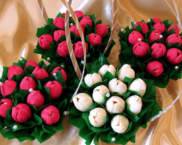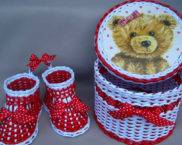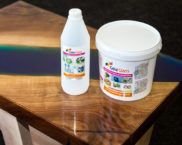The basics of fine art: how to make shades of brown, and what they are called
There is not always the right one color in the palette, and not everyone knows how to get the shade required by the soul. Today our editors decided to conduct a short excursion into the basics of art. This will help not only in construction and design, but also come in handy in creating your own art masterpiece. The topic of our mini-art lesson is how to make brown.
The content of the article
How to get brown from primary colors
Let's see what colors brown can be made from. This ton is actually multifaceted: it is sometimes underestimated, but in vain, because there are a lot of shades. The tone is quite difficult to get, so there are several recommendations and methods for mixing other colors. How to make brown from red, yellow and blue? Mix!
Basic tones: red, blue and yellow. You will find out how to mix them in any proportions below: you can get several shades of brown.
How to get a classic brown color when mixing paints
To make different tones of brown, you will need to vary the amount of pigment or paint. For example, the shade of the tree bark is obtained from red, yellow and blue (indigo) in a ratio of 1: 1: 0.5.
Important! The result will depend not only on maintaining the exact proportions, but also on the quality and type of paint.
How to get reddish brown paint
If more of a red shade is required in a brown tone, then again three primary colors are taken, but in different proportions: 2: 2: 0.5
Advice! If the color on the palette does not come out of the shade you expected, then you should not be afraid to experiment. You can always dilute it in a different tone.
How to get dark brown
How to make a dark brown color? In the shade of brown that you have turned out or have, they bring blue or black. There won't be much difference what exactly to contribute.

The tone is deep. By adding blue or red, you can get an even more interesting shade of dark brown paint.
How to make taupe paint
Everything is simple here: take the standard brown and add white and a drop of black.
How to get light brown
In order not to get the previous shade of paint instead of light brown, you need to add a little red and yellow to the resulting color. If you need a lighter tone, then add white.
What colors need to be mixed to get brown from different types of paints
How to get brown from primary colors, we have defined, but why there are only three primary colors? Because they, in combination with each other, can give a whole palette, with the exception of white. There is such a table in the form color wheel, where are located next to those shades that are close in tone, and on the opposite side, respectively, opposite.

For example, green is closer to blue due to the similarity of tones, but opposite red or orange, as the opposite
Now we will learn how to make brown paint from other colors.
How to make brown from gouache paints
If you connect any two tones from the above circle, then the resulting color will be called secondary. It is not recommended to combine more than three colors, as well as add a lot of black, otherwise, instead of a beautiful shade, you can get an incomprehensible gruel.
Advice! Do not forget that gouache tends to become lighter in 6-7 minutes after application, and we take this into account when obtaining a new color.
To get the tone, it is better to take the desired colors and combine them in a stroke on the palette.
- First way. Try pairing green and red. In the absence of green, use a combination of yellow and blue. Thus, a beautiful brown tone can be obtained consistently.
- Second way - adding a blue tone to orange. No orange? No problem. Mix yellow and red!
- Another way consists in mixing red and blue - you get a purple tone. But add a little yellow to it and voila: you are guaranteed a beautiful brown color.
A light coffee-milky shade can be obtained by mixing gray and orange. Gray paint works great when combining white and black. A dark coffee shade is obtained by mixing purple and acid orange. A shaded brown will work if you mix a light green tone with a bright purple. Here's a short video with mixing tips.
Video: how to get brown

Sometimes the gouache remains in the lids, you can also mix colors in them - the mixture will not dry out, and you can use it again
How to make acrylic-based paints brown
If you are new to working with acrylic and want to know how to make brown from paints, then here is the first important information: the tint color is added in small portions to the base! The second important mixing rule is that you cannot immediately apply color to the main drawing - wait until it dries to make sure it is the correct tone.
You can use the experimental mixing method to create a similar table and use it. To obtain brown shades, burnt umber is added, a brown mineral paint, which gives the whole spectrum: from beige to dark woody.
Important! After each mixing of paints, the brush is washed in water.
When is it profitable to mix colors, and when is it better to buy ready-made paint
If there is a brown tone in the base color set, it will most likely be standard. Therefore, you still have to get the desired shade by combining several different colors. But if the question arose whether it is profitable to buy a ready-made paint, then we will answer: it is beneficial to have a basic set that makes it easier to obtain the remaining shades. But, as can be seen from the article, even many paints can be dispensed with for a while, simply by combining the existing primary colors.
Do not be afraid to try, and your creativity will only bring positive emotions!






















